Monaco hosted Angers this past Tuesday in Ligue 1 action. Monaco kicked off Tuesday’s clash sitting behind Angers in the Ligue 1 table by a point. However, they managed to earn a tight 1-0 win in Tuesday’s game which now puts them above Angers and into the top half of the table.
This game saw Robert Moreno earn his first Ligue 1 win as Monaco head coach. The former Spain manager, and understudy to Luis Enrique, began his Monaco tenure positively, earning a 3-3 draw away to PSG. However, Moreno has found life more difficult in recent weeks. He will undoubtedly be pleased to have finally gotten his first Ligue 1 win under his belt.
This tactical analysis piece will examine the successful tactics deployed by Moreno’s Monaco side in this game. We will analyse Monaco’s effective attacking strategy, as well as the defensive tactics which helped them keep a clean sheet. We will also dissect how Angers’ tactics caused problems for Monaco in Tuesday’s fixture.
Lineups and formations
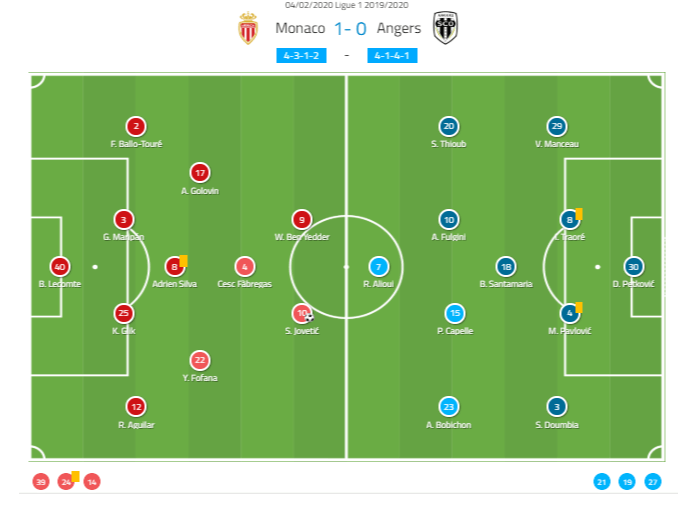
Having previously been the long-term assistant coach of Luis Enrique, it is evident that one thing that Moreno has inherited from his former mentor is his famed unpredictability. Enrique often talks about and provides examples of the importance of unpredictability to his squads. It’s early days, but Moreno may already be showing similarities to Enrique in that regard.
Having previously lined his Monaco side up in a 4-2-3-1, a 4-3-3, and a 4-4-2, Enrique opted for a 4-3-1-2 shape for Tuesday’s game. The only notable change to Monaco’s defence for Tuesday’s game was the inclusion of Ruben Aguilar at right-back. Aguilar enjoyed his first start under Moreno in this game.
January signing Youssouf Fofana joined Adrien Silva and Aleksandr Golovin in central midfield. That trio played behind Cesc Fàbregas in the ‘10’ position. Fàbregas played behind the strike partnership of Wissam Ben Yedder and Stevan Jovetić who also enjoyed his first start under Moreno in this game.
Angers were less unpredictable than Monaco in terms of shape for this game. They set up in their usual 4-1-4-1 shape for Tuesday’s fixture. However, Angers did have some notable absent personnel for this game.
Firstly, Souleyman Doumbia started at left-back for this one instead of the absent Rayan Aït-Nouri. Antonin Bobichon enjoyed a start at left-wing, as Thomas Mangani’s absence forced Pierrick Capelle into central midfield. Usual starting centre-back Romain Thomas took to the bench as Mateo Pavlović took to the field in his stead.
Lastly, usual first-choice goalkeeper Ludovic Butelle only made the bench here as Danijel Petković enjoyed his first Ligue 1 start of the season.
Fofana and Golovin’s deep role in Monaco’s build-up
Monaco’s 4-3-1-2 shape gave them a natural superiority in the centre of the pitch over Angers’ 4-1-4-1. However, in-possession, Monaco’s full-backs were tasked with advancing further up the wing in order to provide width for the team. Only one of Monaco’s two full-backs would usually advance forward at a time. Meanwhile, the other full-back would sit back providing defensive cover.
Furthermore, in order to allow the full-backs to push up and provide support to the defence in the build-up, one of Monaco’s two wide central-midfielders usually dropped deep, vacating their central midfield position and essentially occupying the empty full-back position.
This was a particularly effective tactic for Monaco in the build-up during the first half of this game. We saw Monaco build up in this manner on both wings throughout the first half. This tactic was particularly successful on Monaco’s right-wing, as Fofana dropped deep, allowing Aguilar to advance forward.
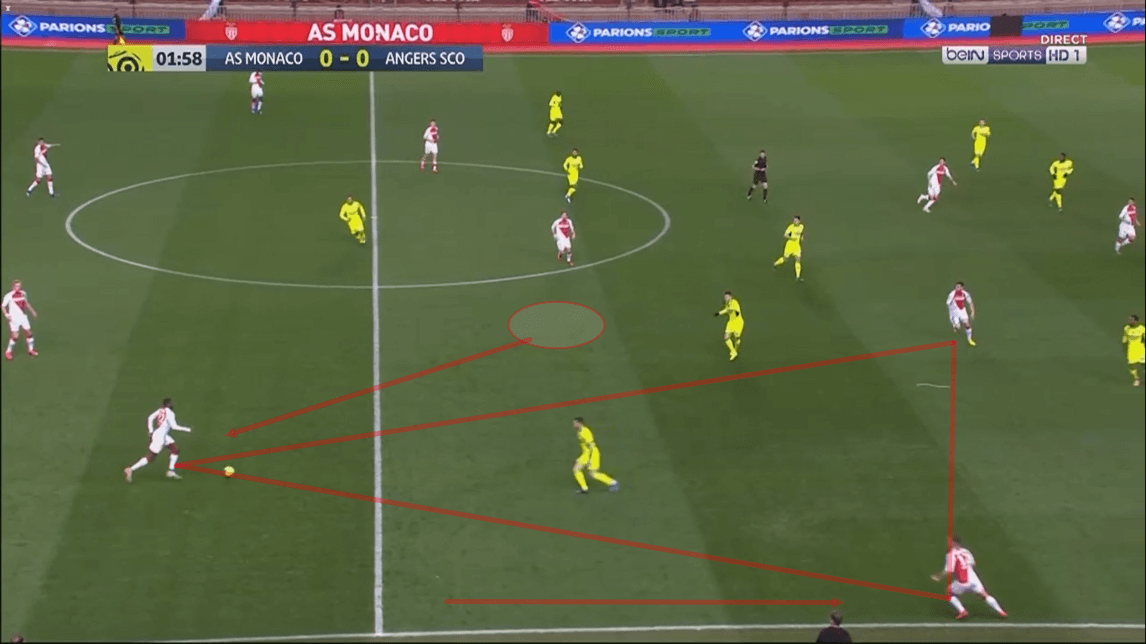
This image above shows us an example of these tactics in action during Monaco’s build-up play. We can see that Fofana has dropped from the midfield in order to move to the right-back position. Meanwhile, Aguilar has assumed a position further up the right-wing. We can also see the ‘10’, Fàbregas, shifting over to the right-wing, offering support.
These tactics in the build-up allowed Monaco to retain their 4-3-1-2 shape. However, instead of three centre-midfielders, Fofana dropping to right-back, allowing Aguilar to play as a wide midfielder in the build-up. This movement combined with the movement of Fàbregas created a wide overload for Monaco in the build-up.
Angers did not press Monaco particularly aggressively during the build-up at the beginning of this game. As a result, Fofana’s movement into a deeper position also allowed him to enjoy time and space to effectively create chances for his side through the use of long-balls.
Fofana attempted to play a long-ball from this deep position seen above to his centre-forwards on a few occasions. As he dropped into this deep position, he often had his head up looking for the movement of his centre-forwards’ runs in behind Angers’ backline, as well as the movement of Fàbregas and Aguilar.
One of Fofana’s long-balls found an excellent run from Jovetić. Fofana’s pass found Jovetić’s head as he opened the scoring for Monaco in the 17th minute. Fofana and Golovin’s movement played an important role in advancing the ball up the pitch. However, this movement also served to get Fofana and Golovin into space in which they could directly create goalscoring chances.
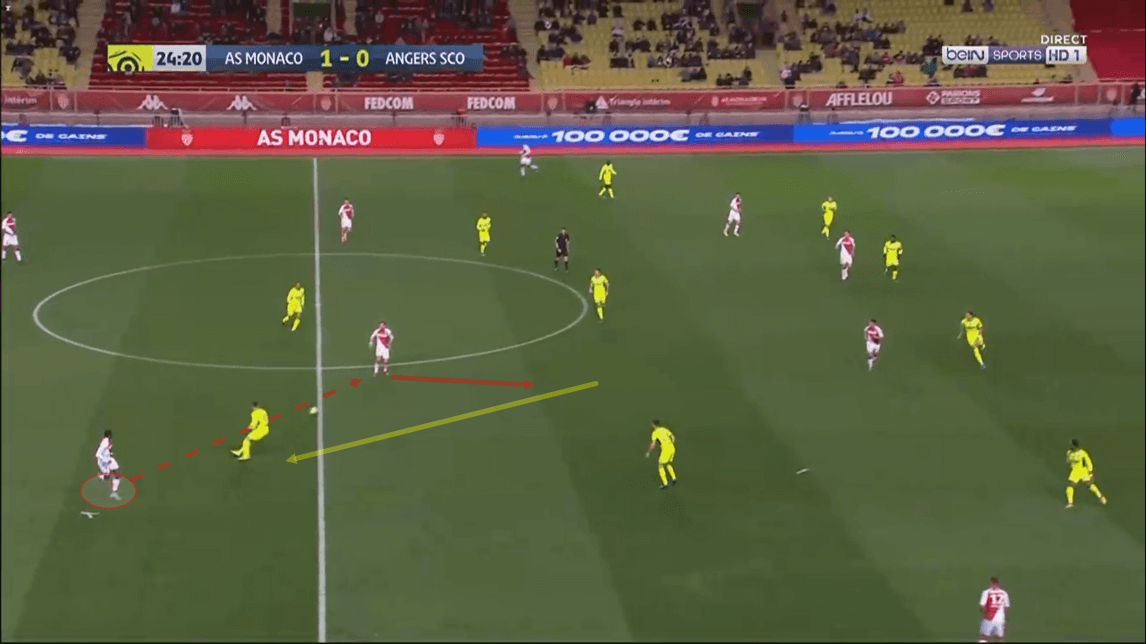
Following the creation of the first goal, Angers began to press Fofana and Golovin slightly more aggressively in these positions. The corresponding Angers centre-midfielder would usually be the one to follow either Fofana or Golovin as they dropped deep. This second image shows us an example of this.
As the Angers midfielder followed Fofana deep here, he reduces the time Fofana has on the ball. However, this press also created gaps in Angers’ midfield. As he is pressed, Fofana is able to play a quick pass to Silva in central midfield. Silva is subsequently able to carry the ball forward and advance play for Monaco.
This shows us how, when pressed, Fofana and Golovin’s movement was effective at helping Monaco to build-up through the centre of the pitch.
Monaco finding the third man
The creation of wide overloads was a particularly important part of Monaco’s attacking tactics in the first half. They aimed to create wide overloads to either create space for an overlapping full-back so that they could enjoy a crossing opportunity or otherwise, in order to create freedom for players in the half-spaces.
Monaco’s quick passing combinations and use of the third man were pivotal in their chance creation. They created space for their full-backs and central players in the half-spaces, due to their quick passing plays and effective third man plays.
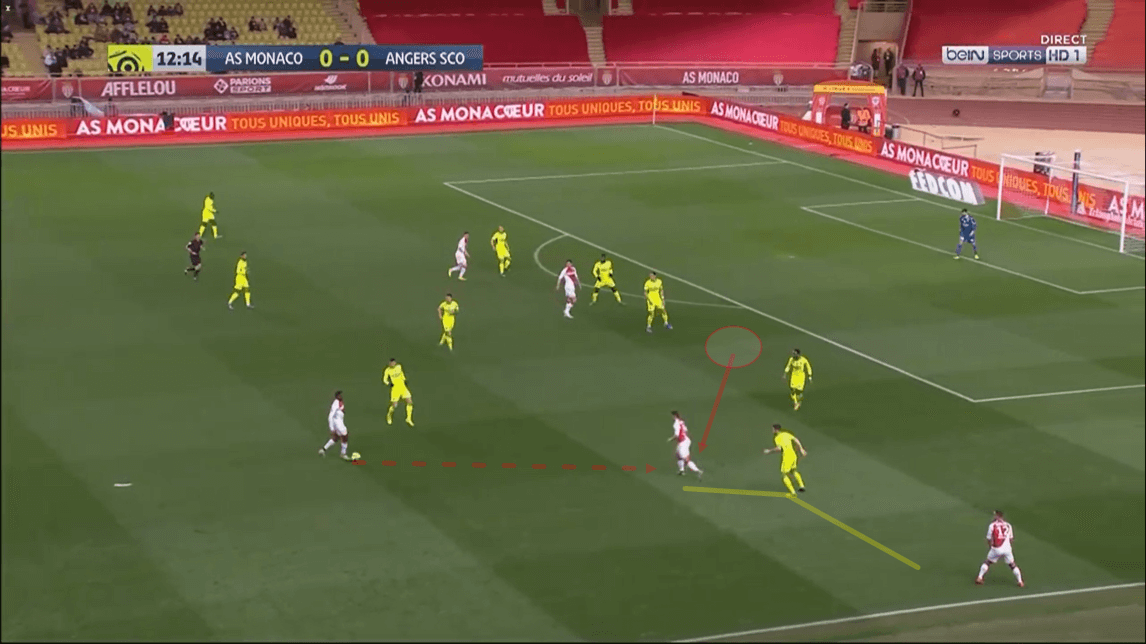
The image above shows us an example of how Monaco created crossing opportunities for Aguilar by making him the free man in a quick and effective passing sequence on Monaco’s right-wing.
Here, we can see Fofana in-possession of the ball in central midfield. We can also see Ben Yedder offering Fofana a simple short passing option. Ben Yedder had vacated his centre-forward position in order to occupy the half-space on this occasion. This allowed Fàbregas to stay central alongside Jovetić.
Ben Yedder’s movement creates a 2v1 advantage for Monaco versus the Angers left-midfielder, Bobichon. However, we can see that left-back Doumbia is relatively free due to Ben Yedder’s movement. If Fofana played the ball out to Aguilar directly here, Doumbia may be able to press him effectively.
Instead, Fofana plays the ball into the feet of Ben Yedder. He subsequently moves into the vacated space to the right of Doumbia. Fofana’s movement into this space prevents Doumbia from enjoying the freedom to move out and press Aguilar, should he need to.
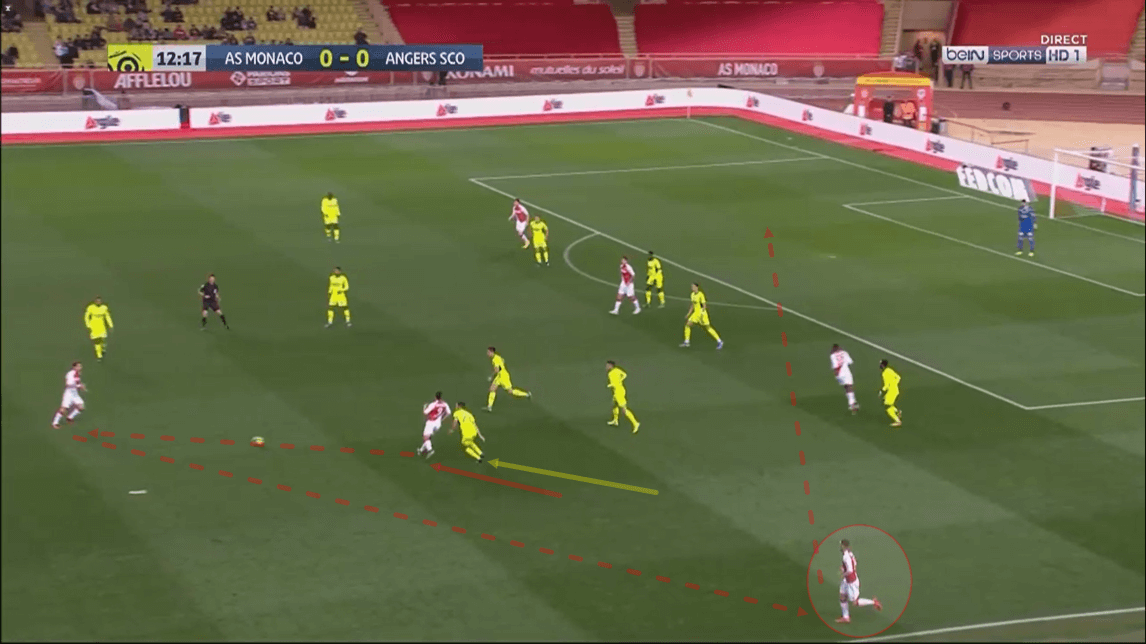
This second image shows us the aftermath of Fofana’s pass to Ben Yedder. As Ben Yedder received the ball he carried it slightly infield. This movement was effective as his marker, Bobichon, follows him into the midfield. Ben Yedder subsequently plays the ball to Silva who then finds Aguilar as the free man on the right-wing. Aguilar is able to get his head up and play a cross into the box.
This sequence provides us with just one example of how Monaco effectively used third man passes to forge chances.
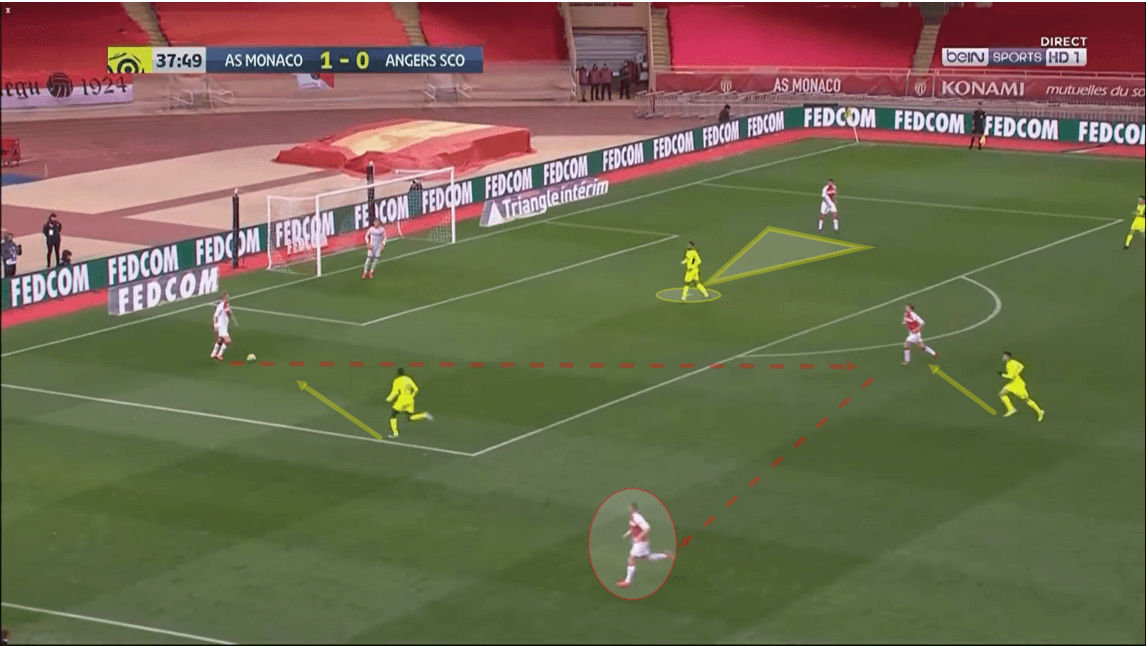
Monaco’s quick passing sequences and third man passes were also effective at helping them to progress play in the build-up. Once they went behind and the first-half wore on, Angers began to press Monaco more aggressively. We can see an example of Angers pressing Monaco aggressively in the build-up in this image. However, in the first half, Monaco didn’t really struggle to beat Angers’ press.
This image shows us the beginning of a sequence in which Monaco manage to play past Angers’ press due to a quick passing sequence and effective third man passes. We can see Sada Thioub, now on the left-wing, pressing Kamil Glik, in-possession here. Meanwhile, centre-forward Rachid Alioui cuts off the passing lane to left centre-back Guillermo Maripán. We can also see Capelle moving towards Silva in the centre.
However, Glik plays the ball to Silva despite the press of the on-rushing Capelle. Silva quickly plays the ball out to right-back Aguilar, who acts as the third man on this occasion. This effectively breaks the first line of Angers’ press.
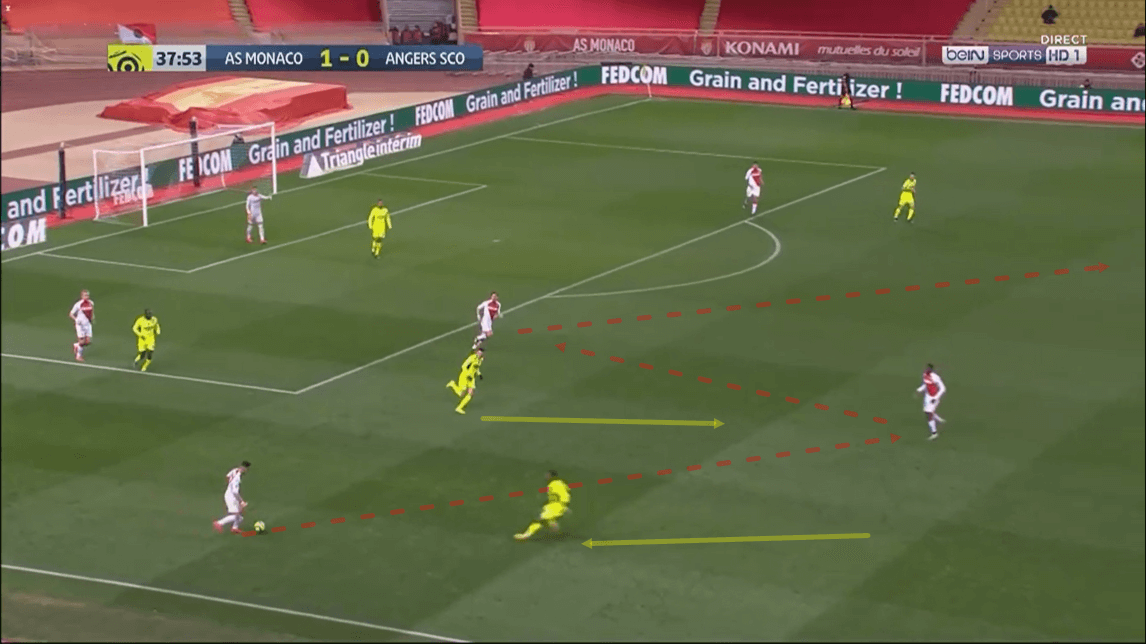
This second image shows us how Monaco continue to play their way past Angers’ press as play moves on. Aguilar is quickly pressed by left-back Doumbia as he receives possession. However, he is able to play the ball into Fofana. As the retreating Capelle then begins to press Fofana, he can find Silva as the third man. Silva is subsequently able to play the ball to Golovin further up the pitch.
This sequence shows us how Monaco effectively used quick passing sequences in the build-up in the first half. When Angers began to press them aggressively, they were able to effectively play past their press.
Angers finding space on the wings
As we mentioned previously, Monaco’s 4-3-1-2 shape gave them numerical superiority in the central areas. This shape effectively prevented Angers from playing through the centre of the pitch for much of the first half. Monaco retained this defensive shape without shifting over to either wing too much as the ball moved.
During the first half, Monaco seemed content with allowing Angers to enjoy time and space on the wings. They focused on retaining a narrow shape and a central overload by defending more narrow. Monaco also didn’t press angers particularly aggressively in this game. They preferred to defend deeper. However, Angers managed to create some problems for Monaco due to the time and space they were allowed out wide.
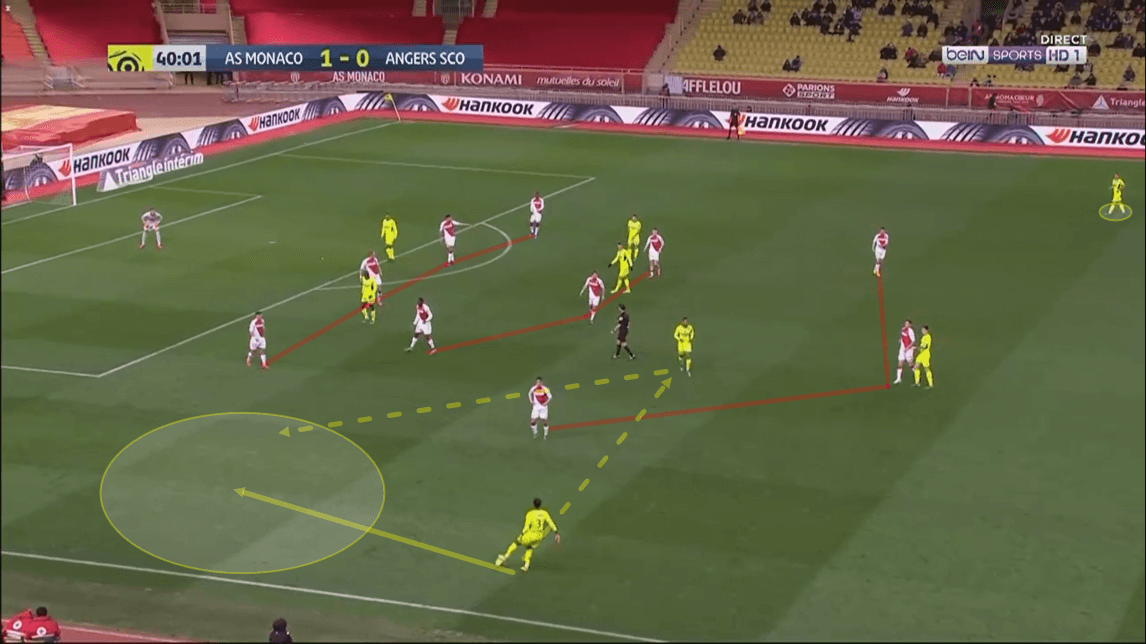
This image above shows us an example of Monaco’s narrow shape. We can see all four of Monaco’s defenders sitting within the length of their box. Their central midfielders and attackers can also be seen within this narrow area here.
Monaco appear in more of a 4-3-2-1 shape than a 4-3-1-2 on this occasion as Jovetić can be seen marking Angers’ holding midfielder Baptiste Santamaria. However, the narrow width of their shape doesn’t change, regardless.
Angers’ full-backs often found themselves in-possession in the wide areas due to Monaco’s narrow width. We can see right-back Vincent Manceau sitting wide on the right flank, similarly to Doumbia here on the left. As play moves on, Doumbia plays a one-two with Angelo Fulgini around Ben Yedder. Doumbia then finds himself in space further up the left-wing. From there, he can cross from a dangerous position.
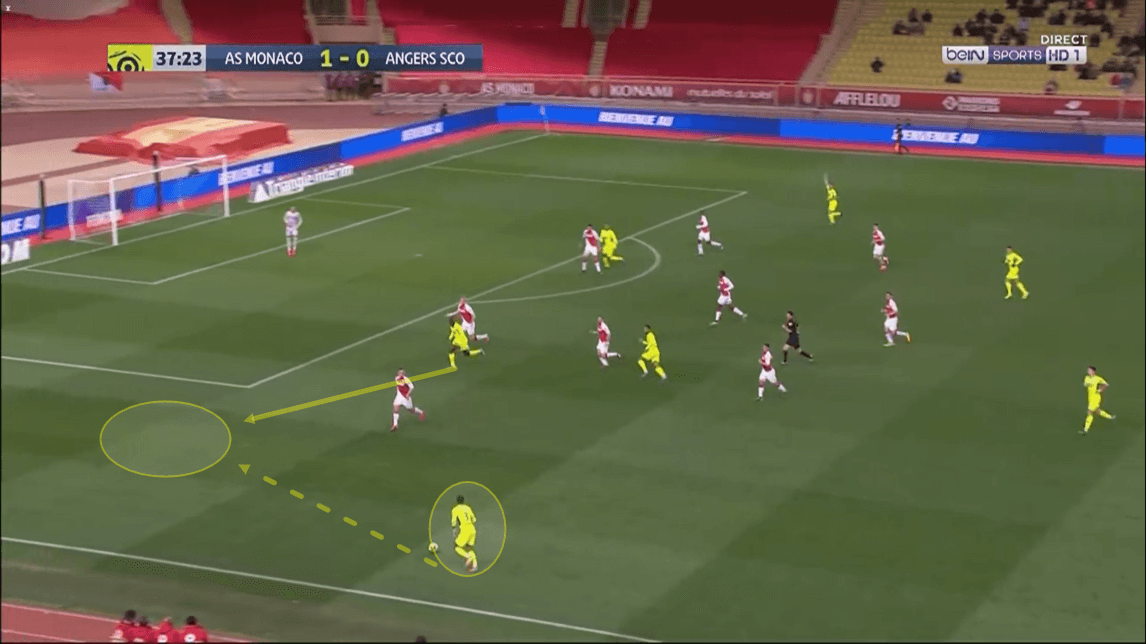
On occasion, Angers’ wide forwards made outward runs from their narrow positions into the space behind Monaco’s full-backs. We can see an example of this in the image above. As Doumbia is progressing down the left-wing, Thioub begins to prove into space behind Aguilar higher up on the left-wing.
Doumbia plays the ball through to Thioub who drives towards the byline. Thioub subsequently attempts to play a cross but wins a corner.
Angers caused problems for Monaco in the wide areas throughout the first half of this game. They gambled on their effectiveness at defending Angers’ crosses from the centre by keeping more defenders central and allowing Angers to enjoy the width. However, some individual defending errors and some decent crossing from Angers created some dangerous scoring opportunities.
Monaco’s second-half switch to a 4-4-2 gives Angers less space out wide
Monaco set-up slightly differently in the second half of this game compared to the first, when out-of-possession. In the first half, they set-up in a narrow 4-3-1-2 and allowed Angers to enjoy space in the wide areas. However, they switched to a wider 4-4-2 in the second half. This shape was created by Jovetić dropping into a left-midfield position out-of-possession.
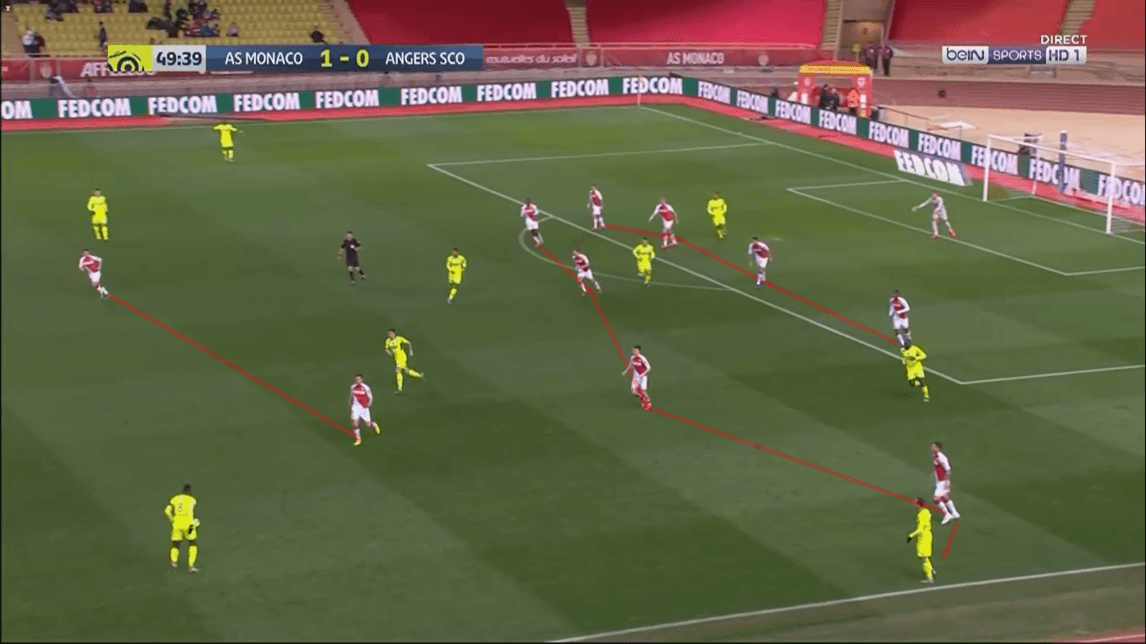
We can see an example of Monaco defending much wider in this 4-4-2 shape in the image above. As we can see, Jovetić is sitting on Angers right-back Manceau, who is positioned high on the right-wing. His positioning prevents Manceau and Angers from enjoying the space they enjoyed on the wings in the first half.
We can see that Monaco’s other three midfielders are still sitting quite narrow. This ensures Monaco don’t give up the numerical advantage in midfield. When the ball was played to the opposite wing, Fofana would assume a wider, right-midfield position. Jovetić would then subsequently shift into a more central position.
Monaco’s 4-4-2 allowed them to defend the wings much more effectively in the second half. This prevented Angers from quickly creating attacks down the wings. Monaco still didn’t press Angers particularly aggressively. If anything, they may have defended deeper in the second half than they did in the first.
Angers enjoyed plenty of possession as a result of Monaco’s passive defence. However, they failed to capitalise on their possession due to the effectiveness of Monaco’s deep 4-4-2 block. As we can see in this image, as well as providing defensive width, this shape allowed Angers very little space in between the lines. Monaco’s 4-4-2 was very compact. It was effective at helping them see out this game.
Monaco’s quick counter-attacks
Monaco’s deep defensive line invited Angers to commit numbers forward. As Monaco forced turnovers in deep areas, they were subsequently able to counter-attack effectively throughout this fixture. Monaco’s central overloads were particularly useful in the transition from defence to attack. They effectively counter-attacked Angers through the centre due to their numerical advantage.
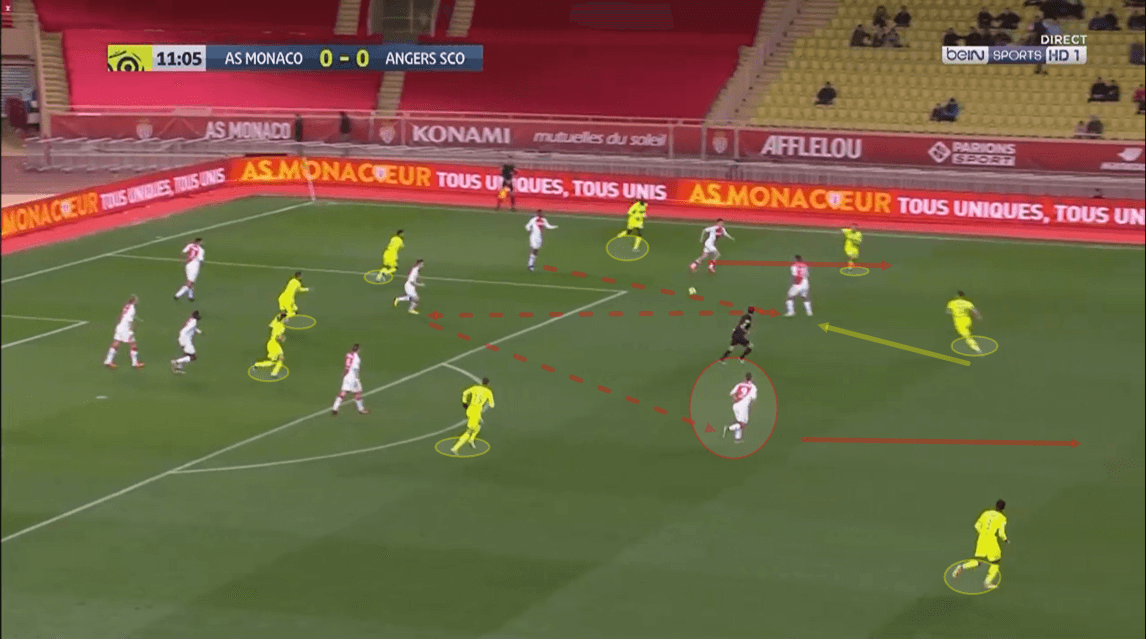
The image above provides us with an example of Monaco counter-attacking Angers through the centre early on in this game. As we can see here, Monaco have just won the ball back deep in their own half. Angers had committed a large number of men forward in attack. We can see six of their players playing very high here, with only Santamaria and Doumbia in midfield and the two centre-backs sitting back out-of-frame.
Fodé Ballo-Touré wins the ball back for his side. As he does so, he plays the ball into the feet of his nearest teammate, Jovetić. The pass to Jovetić attracts Santamaria who then presses Jovetić. However, Jovetić quickly plays the ball back to Fàbregas, who receives the ball with the whole pitch in front of him. He can find Ben Yedder as the free man in central midfield. He subsequently carries the ball forward.
This shows us how Monaco’s quick passing plays were effective in helping them transition from defence to attack. Furthermore, this shows us how Angers commitment of bodies to the attack left their midfield weak following turnovers. This allowed Monaco to exploit their midfield advantage on the counter-attack throughout this game.
Monaco’s effective counter-attacking became their main source of creativity in the second half. They began to defend much deeper and play more direct as Angers pressed more aggressively and committed more men forward. Their counter-attacks through the centre played a big role in their tactics in this game.
Conclusion
To conclude this tactical analysis piece, it is clear that Monaco’s effectiveness in the build-up, as well as their quick passing sequences, third man plays and transitions from defence to attack, were all key components to their effective tactics from Tuesday’s 1-0 win over Angers.
Angers effectively created plenty of chances through their effective wing-play. They forced a number of mistakes through their crossing. They may have continued to pressure Monaco’s backline more in the second half, had Monaco not switched to a 4-4-2.
Monaco’s change in shape helped them to defend the wide areas more effectively. This change in tactics was effective in helping them to see out the game this Tuesday.





Comments